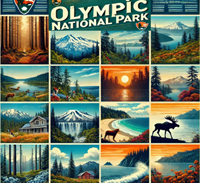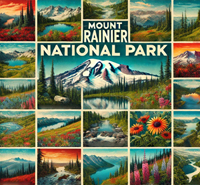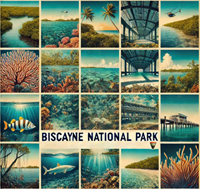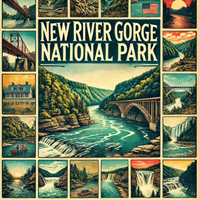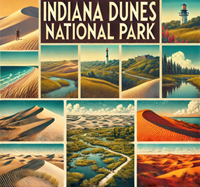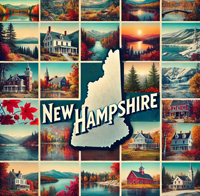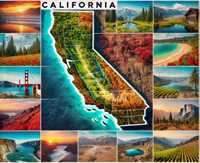
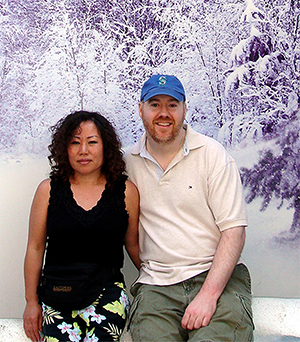
Embark on a journey curated by seasoned explorers William and Hui Cha Stanek, who have spent decades immersing themselves in the diverse landscapes of North America. These itineraries are more than just travel plans - they are thoughtfully crafted adventures designed to help you connect with the natural world, discover hidden gems, and create lasting memories.
National Parks Index | US Itineraries Index | American Roadtrips Index

Bring home a Bugville Critters book and watch as your child's love for reading and learning grows with every page. Hand-painted illustrations bring the heartwarming stories to life. Ask your librarian to add Bugville Critters to the library's digital collection today!
Discover William Stanek's Exclusive Art Collection
Explore and purchase the stunning art featured on this site. Own a piece of William Stanek's unique and captivating artwork today!
(May 2, 2025) Ultimate 5-Day Adventure Through the Black Hills and Beyond: Wind Cave, Jewel Cave, Black Hills National Forest, Custer State Park, Mount Rushmore, and Devils Tower
Introduction: Discovering the Spirit of the American West
The Black Hills region of South Dakota and Wyoming is a place where history, nature, and adventure converge. This area is rich in both geological wonders and cultural significance, offering visitors a unique journey through some of the most iconic landscapes of the American West. From exploring the mysterious depths of Wind Cave and Jewel Cave to hiking through the Black Hills National Forest, witnessing the majesty of Mount Rushmore, and standing in awe beneath Devils Tower, this five-day adventure is designed to immerse you in the spirit of the West.
Each day of this itinerary has been crafted to offer a mix of exploration, reflection, and adventure, with plenty of opportunities to connect with the history and natural beauty of this remarkable region. We'll share personal stories, photography tips, and alternative activities to ensure that your trip is as memorable and enjoyable as possible.
Join us as we embark on a journey through the Black Hills and beyond, where every turn offers a new discovery and every moment becomes a lasting memory.
Day 1: Wind Cave National Park – Journey Beneath the Surface
Morning: Natural Entrance Tour at Wind Cave
Overview
Start your adventure with a morning tour of Wind Cave, one of the longest and most complex caves in the world. The Natural Entrance Tour is a great way to experience the unique boxwork formations that make Wind Cave famous. This moderately challenging tour takes you through narrow passageways and large chambers, offering a fascinating glimpse into the underground world.
Tips from William
"Wind Cave is a challenging environment for photography, but it's well worth the effort. Bring a camera with good low-light capabilities and a tripod to capture the intricate boxwork formations. Use slow shutter speeds and a small aperture to keep the entire scene in focus."
Insights from Hui Cha
"Exploring Wind Cave is like stepping into another world. The cool air, the sound of dripping water, and the sight of the ancient formations create a sense of wonder and connection to the earth. Dress warmly, as the cave is cool year-round, and wear sturdy shoes for navigating the uneven terrain."
How to Access Wind Cave
Directions:
- From Custer, South Dakota, take US-385 south to Wind Cave National Park. The visitor center is the starting point for all cave tours.
Tour Details:
- Location: Wind Cave National Park, SD
- Tour Length: 1 hour, 0.6 miles round-trip
- Difficulty: Moderate (due to stairs and tight spaces)
Photography Tips: For the best shots inside Wind Cave, focus on capturing the texture and details of the boxwork formations. A tripod is essential for stabilizing your camera in the low light, and a wide-angle lens will help you capture the scale of the underground chambers.
Alternative Activity: If the Natural Entrance Tour sounds too challenging, consider taking the Garden of Eden Tour, a shorter and less strenuous tour that offers beautiful views of cave formations in larger, more accessible chambers.
Mid-Morning: Hiking the Rankin Ridge Trail
Overview
After your cave tour, head to the surface for a hike on the Rankin Ridge Trail, a short but scenic trail that leads to the highest point in Wind Cave National Park. The trail offers panoramic views of the Black Hills, the surrounding prairie, and the distant Badlands, making it a perfect spot for photography and wildlife viewing.
Tips from William
"The Rankin Ridge Trail is perfect for landscape photography. Bring a wide-angle lens to capture the expansive views of the Black Hills and the prairie, and a telephoto lens to zoom in on the details of the plants and wildlife. The best light for photography is in the mid-morning when the sun is high enough to illuminate the landscape but not too harsh."
Insights from Hui Cha
"Hiking the Rankin Ridge Trail is a peaceful way to experience the beauty of Wind Cave National Park. The sight of the rolling hills, the sound of the wind in the grass, and the views from the top create a sense of connection to the land and the natural world."
How to Access the Rankin Ridge Trail
Directions:
- The Rankin Ridge Trailhead is located off SD-87, just north of the visitor center. The trail is well-marked and easy to follow.
Trail Details:
- Trail Length: 1 mile loop
- Elevation Gain: 250 feet
- Difficulty: Easy to Moderate
Photography Tips: For the best shots along the Rankin Ridge Trail, focus on capturing the contrast between the rolling hills and the vast prairie. A tripod can help stabilize your camera for sharp images, especially in the low light under the trees.
Alternative Activity: If the hike to Rankin Ridge sounds too challenging, consider exploring the nearby Prairie Vista Trail, a 1-mile loop that offers beautiful views of the prairie and the chance to see bison and prairie dogs.
Afternoon: Wildlife Watching on the Prairie
Overview
In the afternoon, explore the open prairies of Wind Cave National Park, where you can observe bison, elk, prairie dogs, and other wildlife. The park's mixed-grass prairie is a unique and important ecosystem, home to a wide variety of animals and plants. A drive along the park's scenic roads provides plenty of opportunities for wildlife viewing and photography.
Tips from William
"The open prairies of Wind Cave are ideal for wildlife photography. Bring a telephoto lens to capture close-up shots of the animals, and a wide-angle lens for landscape shots that include both the wildlife and the surrounding scenery. The best light for photography is in the late afternoon when the sun is low in the sky and the shadows are long."
Insights from Hui Cha
"Watching wildlife on the prairie is a peaceful and inspiring experience. The sight of bison grazing in the tall grass, the sound of the wind rustling through the prairie, and the beauty of the wide-open spaces create a sense of connection to the natural world. Remember to keep a safe distance from the animals, and use binoculars for the best views."
How to Access the Prairie
Directions:
- From the visitor center, take US-385 north or south to explore the park's scenic roads. Wildlife can often be seen from the road, or you can stop at one of the many pullouts for a closer look.
Wildlife Viewing Details:
- Location: Wind Cave National Park, SD
- Difficulty: Easy (drive with short walks)
Photography Tips: For the best wildlife shots, focus on capturing the animals in their natural habitat, with the prairie as a backdrop. Use a telephoto lens to zoom in on the details, and a tripod or monopod to stabilize your camera for sharp images.
Alternative Activity: If driving through the park sounds too sedentary, consider taking a short walk on the Lookout Point Trail, a 1.5-mile loop that offers beautiful views of the prairie and the chance to see wildlife up close.
Evening: Sunset at the Beaver Creek Overlook
Overview
End your day at Wind Cave National Park with a sunset at Beaver Creek Overlook, a scenic spot that offers stunning views of the Black Hills and the surrounding prairie. The overlook is a perfect place to relax and reflect on your day while watching the sun set over the rolling hills.
Tips from William
"Beaver Creek Overlook is a fantastic spot for sunset photography, with wide, sweeping views of the prairie and hills. Set up your tripod well before sunset to find the best angle, and use a wide-angle lens to capture the full scene. A graduated neutral density filter will help balance the exposure between the bright sky and the darker landscape."
Insights from Hui Cha
"Watching the sunset at Beaver Creek Overlook is a peaceful and beautiful experience. The colors of the sky, the stillness of the prairie, and the sound of the wind in the trees create a sense of calm and connection to nature. It's a perfect way to end the day."
How to Access Beaver Creek Overlook
Directions:
- Beaver Creek Overlook is located off SD-87, south of the visitor center. The overlook is a short walk from the parking area.
Viewpoint Details:
- Location: Beaver Creek Overlook, Wind Cave National Park
- Elevation Gain: Minimal
- Difficulty: Easy
Photography Tips: For a stunning sunset shot, position yourself on the western side of the overlook to capture the last light of the day as it illuminates the hills and prairie. Use a small aperture (f/16 or smaller) to keep the entire scene in focus, and experiment with different shutter speeds to capture the changing light.
Alternative Activity: If watching the sunset from Beaver Creek Overlook sounds too isolated, consider heading to the nearby Buffalo Gap National Grassland, where you can watch the sunset over the wide-open prairie with the chance to see more wildlife.
Day 2: Jewel Cave National Monument – The Glittering Underground
Morning: Scenic Tour of Jewel Cave
Overview
Start your second day with a Scenic Tour of Jewel Cave, the third longest cave in the world. This tour takes you through a series of large chambers adorned with sparkling calcite crystals, stalactites, and other unique formations. The Scenic Tour is a moderately challenging tour that offers a fascinating look at the underground wonders of Jewel Cave.
Tips from William
"Jewel Cave is a photographer's dream, with its sparkling crystals and unique formations. Bring a camera with good low-light capabilities and a tripod to capture the details of the cave. Use slow shutter speeds and a small aperture to keep the entire scene in focus."
Insights from Hui Cha
"Exploring Jewel Cave is like stepping into a hidden world. The cool air, the sound of dripping water, and the sight of the glittering crystals create a sense of wonder and connection to the earth. Dress warmly, as the cave is cool year-round, and wear sturdy shoes for navigating the uneven terrain."
How to Access Jewel Cave
Directions:
- From Custer, South Dakota, take US-16 west to Jewel Cave National Monument. The visitor center is the starting point for all cave tours.
Tour Details:
- Location: Jewel Cave National Monument, SD
- Tour Length: 1 hour 20 minutes, 0.5 miles round-trip
- Difficulty: Moderate (due to stairs and uneven terrain)
Photography Tips: For the best shots inside Jewel Cave, focus on capturing the sparkle and texture of the calcite crystals. A tripod is essential for stabilizing your camera in the low light, and a wide-angle lens will help you capture the scale of the underground chambers.
Alternative Activity: If the Scenic Tour sounds too challenging, consider taking the Discovery Talk, a shorter and less strenuous tour that offers a brief look at one of the cave's most beautiful chambers.
Mid-Morning: Hiking the Canyons Trail
Overview
After your cave tour, take a hike on the Canyons Trail, a scenic trail that winds through the rugged terrain surrounding Jewel Cave. The trail offers beautiful views of the Black Hills, the surrounding forest, and the chance to see wildlife such as deer and wild turkeys.
Tips from William
"The Canyons Trail is perfect for landscape photography. Bring a wide-angle lens to capture the expansive views of the Black Hills and a telephoto lens to zoom in on the details of the plants and wildlife. The best light for photography is in the mid-morning when the sun is high enough to illuminate the landscape but not too harsh."
Insights from Hui Cha
"Hiking the Canyons Trail is a peaceful way to experience the beauty of Jewel Cave National Monument. The sight of the rolling hills, the sound of the wind in the trees, and the views from the top create a sense of connection to the land and the natural world."
How to Access the Canyons Trail
Directions:
- The Canyons Trailhead is located near the Jewel Cave Visitor Center. The trail is well-marked and easy to follow.
Trail Details:
- Trail Length: 3.5 miles loop
- Elevation Gain: 500 feet
- Difficulty: Moderate
Photography Tips: For the best shots along the Canyons Trail, focus on capturing the contrast between the rugged terrain and the surrounding forest. A tripod can help stabilize your camera for sharp images, especially in the low light under the trees.
Alternative Activity: If the Canyons Trail sounds too challenging, consider exploring the nearby Roof Trail, a 0.8-mile loop that offers beautiful views of the forest and the chance to see wildlife with less elevation change.
Afternoon: Exploring the Scenic Byway in Black Hills National Forest
Overview
In the afternoon, take a scenic drive through Black Hills National Forest, where you can explore the region's rugged beauty from the comfort of your car. The Peter Norbeck Scenic Byway is a particularly beautiful route, offering stunning views of the forest, rock formations, and the chance to see wildlife such as bighorn sheep and mountain goats.
Tips from William
"The Black Hills Scenic Byway is perfect for landscape and wildlife photography. Bring a telephoto lens to capture close-up shots of the wildlife and a wide-angle lens for landscape shots that include the forest and rock formations. The best light for photography is in the late afternoon when the sun is low in the sky and the shadows are long."
Insights from Hui Cha
"Driving through the Black Hills is a peaceful and inspiring experience. The sight of the towering pines, the sound of the wind in the trees, and the beauty of the rugged landscape create a sense of connection to the natural world. Take your time and stop at the scenic overlooks to fully appreciate the views."
How to Access the Black Hills Scenic Byway
Directions:
- The Peter Norbeck Scenic Byway begins in Custer, South Dakota, and loops through the Black Hills National Forest. The route is well-marked with signs and offers several scenic pullouts.
Scenic Drive Details:
- Location: Black Hills National Forest, SD
- Difficulty: Easy (drive with short walks)
Photography Tips: For the best shots along the scenic byway, focus on capturing the play of light and shadow on the forest and rock formations. Use a wide-angle lens to capture the expansive views and a telephoto lens to zoom in on the details of the wildlife and landscape.
Alternative Activity: If driving the byway sounds too sedentary, consider stopping at the Black Elk Peak Trailhead, where you can take a short hike to the highest point in the Black Hills, offering panoramic views of the surrounding landscape.
Evening: Sunset at Sylvan Lake
Overview
End your day with a sunset at Sylvan Lake, one of the most beautiful and iconic spots in the Black Hills. The lake, surrounded by towering granite cliffs and lush forest, offers stunning views and is a perfect place to relax and reflect on your day.
Tips from William
"Sylvan Lake is a fantastic spot for sunset photography, with wide, sweeping views of the lake and cliffs. Set up your tripod well before sunset to find the best angle, and use a wide-angle lens to capture the full scene. A graduated neutral density filter will help balance the exposure between the bright sky and the darker landscape."
Insights from Hui Cha
"Watching the sunset at Sylvan Lake is a peaceful and beautiful experience. The colors of the sky, the stillness of the water, and the sound of the wind in the trees create a sense of calm and connection to nature. It's a perfect way to end the day."
How to Access Sylvan Lake
Directions:
- From Custer, South Dakota, take SD-87 north to Sylvan Lake. The lake is located within Custer State Park, and parking is available nearby.
Viewpoint Details:
- Location: Sylvan Lake, Custer State Park
- Elevation Gain: Minimal
- Difficulty: Easy
Photography Tips: For a stunning sunset shot, position yourself on the western side of the lake to capture the last light of the day as it illuminates the cliffs and water. Use a small aperture (f/16 or smaller) to keep the entire scene in focus, and experiment with different shutter speeds to capture the changing light.
Alternative Activity: If watching the sunset at Sylvan Lake sounds too crowded, consider heading to the nearby Legion Lake, where you can enjoy a more secluded sunset experience with equally beautiful views of the Black Hills.
Day 3: Custer State Park – A Journey Through the Heart of the Black Hills
Morning: Wildlife Loop Road
Overview
Start your third day with a drive along the Wildlife Loop Road in Custer State Park, one of the best places in the Black Hills to see wildlife. The loop takes you through open grasslands and rolling hills, where you can observe bison, pronghorn, deer, and wild burros in their natural habitat.
Tips from William
"The Wildlife Loop Road is perfect for wildlife photography. Bring a telephoto lens to capture close-up shots of the animals, and a wide-angle lens for landscape shots that include both the wildlife and the surrounding scenery. The best light for photography is in the early morning when the animals are most active and the light is soft."
Insights from Hui Cha
"Driving the Wildlife Loop Road is a peaceful and inspiring experience. The sight of bison grazing in the tall grass, the sound of the wind rustling through the prairie, and the beauty of the wide-open spaces create a sense of connection to the natural world. Remember to keep a safe distance from the animals, and use binoculars for the best views."
How to Access the Wildlife Loop Road
Directions:
- The Wildlife Loop Road begins near the Custer State Park Visitor Center, located off US-16A. The loop is well-marked and offers several pullouts for wildlife viewing and photography.
Wildlife Viewing Details:
- Location: Custer State Park, SD
- Difficulty: Easy (drive with short walks)
Photography Tips: For the best wildlife shots, focus on capturing the animals in their natural habitat, with the prairie and hills as a backdrop. Use a telephoto lens to zoom in on the details, and a tripod or monopod to stabilize your camera for sharp images.
Alternative Activity: If driving the Wildlife Loop Road sounds too sedentary, consider taking a short hike on the French Creek Trail, a 12-mile out-and-back hike that offers beautiful views of the prairie and the chance to see wildlife up close. You can hike as much or as little of the trail as you like.
Mid-Morning: Hiking to Black Elk Peak
Overview
After your morning drive, embark on a hike to Black Elk Peak, the highest point in the Black Hills and the tallest peak east of the Rockies. The hike is challenging but rewarding, with stunning views of the surrounding landscape from the top. Along the way, you'll pass through lush forests, granite outcrops, and wildflower meadows.
Tips from William
"Black Elk Peak is perfect for landscape and action photography. Bring a wide-angle lens to capture the expansive views from the top, and a telephoto lens to zoom in on the details of the plants and wildlife along the trail. The best light for photography is in the mid-morning when the sun is high enough to illuminate the landscape but not too harsh."
Insights from Hui Cha
"Hiking to Black Elk Peak is a journey through some of the most beautiful and rugged landscapes in the Black Hills. The sight of the forest from the top of the peak, the sound of the wind in the trees, and the challenge of the climb create a sense of achievement and connection to nature."
How to Access Black Elk Peak
Directions:
- The trailhead for Black Elk Peak is located near Sylvan Lake in Custer State Park. The trail is well-marked and includes several steep sections.
Trail Details:
- Trail Length: 7 miles round-trip
- Elevation Gain: 1,100 feet
- Difficulty: Strenuous
Photography Tips: For the best shots along the Black Elk Peak Trail, focus on capturing the contrast between the rugged terrain and the surrounding forest. A tripod can help stabilize your camera for sharp images, especially in the low light under the trees.
Alternative Activity: If the hike to Black Elk Peak sounds too challenging, consider exploring the shorter Cathedral Spires Trail, a 2.3-mile out-and-back hike that offers beautiful views of the granite spires and the surrounding forest with less elevation gain.
Afternoon: Exploring Needles Highway
Overview
In the afternoon, take a drive along Needles Highway, one of the most scenic roads in the Black Hills. The highway winds through narrow tunnels, towering granite spires, and lush forests, offering stunning views at every turn. Along the way, you'll pass several scenic pullouts where you can stop to take in the views and capture photos.
Tips from William
"Needles Highway is perfect for landscape photography. Bring a wide-angle lens to capture the expansive views of the granite spires and the surrounding forest, and a telephoto lens to zoom in on the details of the rock formations. The best light for photography is in the late afternoon when the sun is low in the sky and the shadows are long."
Insights from Hui Cha
"Driving Needles Highway is a peaceful and inspiring experience. The sight of the towering spires, the sound of the wind in the trees, and the beauty of the rugged landscape create a sense of connection to the natural world. Take your time and stop at the scenic pullouts to fully appreciate the views."
How to Access Needles Highway
Directions:
- Needles Highway (SD-87) begins near Sylvan Lake and winds north through Custer State Park. The route is well-marked with signs and offers several scenic pullouts.
Scenic Drive Details:
- Location: Custer State Park, SD
- Difficulty: Easy (drive with short walks)
Photography Tips: For the best shots along Needles Highway, focus on capturing the play of light and shadow on the granite spires and forest. Use a wide-angle lens to capture the expansive views and a telephoto lens to zoom in on the details of the rock formations.
Alternative Activity: If driving Needles Highway sounds too sedentary, consider stopping at the Sylvan Lake Trailhead, where you can take a short hike around the lake, offering beautiful views of the granite cliffs and surrounding forest.
Evening: Sunset at Mount Rushmore National Memorial
Overview
End your day with a sunset visit to Mount Rushmore, one of the most iconic landmarks in the United States. The monument, featuring the faces of George Washington, Thomas Jefferson, Theodore Roosevelt, and Abraham Lincoln carved into the granite of the Black Hills, offers a stunning sight as the sun sets behind the mountains.
Tips from William
"Mount Rushmore is a fantastic subject for sunset photography. Bring a wide-angle lens to capture the full scale of the monument and the surrounding landscape, and a telephoto lens for close-up shots of the details. The best light for photography is in the late evening when the sun is low in the sky and the shadows are long."
Insights from Hui Cha
"Watching the sunset at Mount Rushmore is a powerful and inspiring experience. The sight of the monument illuminated by the setting sun, the colors of the sky, and the history of this place create a sense of connection to the past and the ideals that shaped this country."
How to Access Mount Rushmore
Directions:
- From Custer State Park, take SD-244 west to Mount Rushmore National Memorial. The monument is easily accessible from the road, with parking available nearby.
Viewpoint Details:
- Location: Mount Rushmore National Memorial, SD
- Elevation Gain: None
- Difficulty: Easy
Photography Tips: For a stunning sunset shot, position yourself on the western side of the monument to capture the last light of the day as it illuminates the faces and surrounding cliffs. Use a small aperture (f/16 or smaller) to keep the entire scene in focus, and experiment with different shutter speeds to capture the changing light.
Alternative Activity: If visiting Mount Rushmore sounds too crowded, consider watching the sunset from the nearby Iron Mountain Road, which offers equally beautiful views of the Black Hills and the monument from a distance.
Day 4: Devils Tower National Monument – Sacred Ground
Morning: Sunrise at Devils Tower
Overview
Begin your fourth day with a sunrise visit to Devils Tower, a sacred site to many Native American tribes and a natural wonder in its own right. The towering rock formation, rising 1,267 feet above the surrounding landscape, offers a stunning sight as the first light of the day illuminates its rugged surface.
Tips from William
"Devils Tower is a fantastic subject for sunrise photography. Bring a wide-angle lens to capture the full scale of the tower and the surrounding landscape, and a telephoto lens for close-up shots of the details. The best light for photography is in the early morning when the sun is low in the sky and the shadows are long."
Insights from Hui Cha
"Watching the sunrise at Devils Tower is a peaceful and awe-inspiring experience. The sight of the tower illuminated by the first light of the day, the sound of the wind in the trees, and the sacred history of this place create a sense of connection to the natural world and the spiritual traditions of the region."
How to Access Devils Tower
Directions:
- From Sundance, Wyoming, take US-14 north to Devils Tower National Monument. The monument is easily accessible from the road, with parking available nearby.
Viewpoint Details:
- Location: Devils Tower National Monument, WY
- Elevation Gain: Minimal
- Difficulty: Easy
Photography Tips: For a stunning sunrise shot, position yourself on the eastern side of the tower to capture the first light of the day as it illuminates the rock formation and surrounding landscape. Use a small aperture (f/16 or smaller) to keep the entire scene in focus, and experiment with different compositions to highlight the tower against the changing colors of the sky.
Alternative Activity: If a sunrise visit to Devils Tower sounds too early, consider visiting later in the morning when the light is still good for photography, and you can take a short hike around the base of the tower to explore its unique geology.
Mid-Morning: Hiking the Tower Trail
Overview
After your sunrise visit, take a hike on the Tower Trail, a 1.3-mile loop that circles the base of Devils Tower. The trail offers stunning views of the tower from all angles, as well as opportunities to see wildlife such as deer and prairie dogs. Along the way, you'll also see prayer cloths tied to trees, left by Native American tribes as part of their spiritual practices.
Tips from William
"The Tower Trail is perfect for landscape and documentary photography. Bring a wide-angle lens to capture the expansive views of the tower and the surrounding landscape, and a telephoto lens for close-up shots of the plants and wildlife. The best light for photography is in the mid-morning when the sun is high enough to illuminate the landscape but not too harsh."
Insights from Hui Cha
"Hiking the Tower Trail is a journey through a sacred landscape. The sight of the tower from different angles, the sound of the wind in the trees, and the spiritual significance of this place create a sense of connection to the land and the traditions of the Native American tribes who hold this place sacred."
How to Access the Tower Trail
Directions:
- The Tower Trailhead is located near the visitor center at Devils Tower National Monument. The trail is well-marked and easy to follow.
Trail Details:
- Trail Length: 1.3 miles loop
- Elevation Gain: Minimal
- Difficulty: Easy
Photography Tips: For the best shots along the Tower Trail, focus on capturing the contrast between the rugged surface of the tower and the surrounding forest. A tripod can help stabilize your camera for sharp images, especially in the low light under the trees.
Alternative Activity: If the Tower Trail sounds too challenging, consider exploring the shorter Red Beds Trail, a 2.8-mile loop that offers beautiful views of Devils Tower and the surrounding landscape with a bit more elevation gain.
Afternoon: Exploring the Black Hills National Forest
Overview
In the afternoon, return to the Black Hills National Forest for a deeper exploration of its rugged beauty. The forest offers endless opportunities for hiking, wildlife viewing, and photography, with its dense stands of ponderosa pine, granite outcrops, and hidden waterfalls. Whether you prefer a challenging hike or a leisurely drive, the Black Hills National Forest has something for everyone.
Tips from William
"The Black Hills National Forest is perfect for landscape and wildlife photography. Bring a wide-angle lens to capture the expansive views of the forest and a telephoto lens to zoom in on the details of the plants and wildlife. The best light for photography is in the late afternoon when the sun is low in the sky and the shadows are long."
Insights from Hui Cha
"Exploring the Black Hills National Forest is a peaceful and inspiring experience. The sight of the towering pines, the sound of the wind in the trees, and the beauty of the rugged landscape create a sense of connection to the natural world. Take your time and stop at the scenic overlooks to fully appreciate the views."
How to Access the Black Hills National Forest
Directions:
- The Black Hills National Forest is easily accessible from several points in South Dakota and Wyoming. The forest is crisscrossed by scenic byways and hiking trails, offering plenty of opportunities for exploration.
Hiking Details:
- Location: Black Hills National Forest, SD/WY
- Difficulty: Easy to Strenuous (depending on the trail)
Photography Tips: For the best shots in the Black Hills National Forest, focus on capturing the play of light and shadow on the forest and rock formations. Use a wide-angle lens to capture the expansive views and a telephoto lens to zoom in on the details of the wildlife and landscape.
Alternative Activity: If hiking through the forest sounds too strenuous, consider taking a scenic drive along the Spearfish Canyon Scenic Byway, which offers beautiful views of waterfalls, cliffs, and the forest from the comfort of your car.
Evening: Sunset at Spearfish Canyon
Overview
End your day with a sunset visit to Spearfish Canyon, a stunning gorge carved by Spearfish Creek through the northern Black Hills. The canyon is known for its towering limestone cliffs, lush forests, and picturesque waterfalls, making it a perfect spot to watch the sun set over the rugged landscape.
Tips from William
"Spearfish Canyon is a fantastic spot for sunset photography. Bring a wide-angle lens to capture the full scale of the cliffs and forest, and a telephoto lens for close-up shots of the waterfalls and creek. The best light for photography is in the late evening when the sun is low in the sky and the shadows are long."
Insights from Hui Cha
"Watching the sunset at Spearfish Canyon is a peaceful and beautiful experience. The colors of the sky, the stillness of the creek, and the sound of the wind in the trees create a sense of calm and connection to nature. It's a perfect way to end the day."
How to Access Spearfish Canyon
Directions:
- Spearfish Canyon is located off US-14A in the northern Black Hills. The canyon is easily accessible from the road, with parking available at several pullouts.
Viewpoint Details:
- Location: Spearfish Canyon, Black Hills National Forest
- Elevation Gain: Minimal
- Difficulty: Easy
Photography Tips: For a stunning sunset shot, position yourself along the creek to capture the last light of the day as it illuminates the cliffs and forest. Use a small aperture (f/16 or smaller) to keep the entire scene in focus, and experiment with different shutter speeds to capture the changing light.
Alternative Activity: If watching the sunset at Spearfish Canyon sounds too crowded, consider heading to the nearby Roughlock Falls, where you can enjoy a more secluded sunset experience with equally beautiful views of the canyon and waterfalls.
Day 5: Custer State Park – A Final Exploration
Morning: Sunrise at the Needles Eye
Overview
Begin your final day with a sunrise visit to the Needles Eye, one of the most iconic rock formations in the Black Hills. The narrow granite spire, with its small opening resembling an eye, offers a stunning sight as the first light of the day illuminates its rugged surface. The Needles Eye is a popular spot for rock climbing and photography, offering breathtaking views of the surrounding landscape.
Tips from William
"The Needles Eye is a fantastic subject for sunrise photography. Bring a wide-angle lens to capture the full scale of the spire and the surrounding landscape, and a telephoto lens for close-up shots of the details. The best light for photography is in the early morning when the sun is low in the sky and the shadows are long."
Insights from Hui Cha
"Watching the sunrise at the Needles Eye is a peaceful and awe-inspiring experience. The sight of the spire illuminated by the first light of the day, the sound of the wind in the trees, and the rugged beauty of the Black Hills create a sense of connection to the natural world and the adventure that lies ahead."
How to Access the Needles Eye
Directions:
- The Needles Eye is located along Needles Highway (SD-87) in Custer State Park. The spire is easily accessible from the road, with parking available nearby.
Viewpoint Details:
- Location: Needles Eye, Custer State Park
- Elevation Gain: Minimal
- Difficulty: Easy
Photography Tips: For a stunning sunrise shot, position yourself on the eastern side of the spire to capture the first light of the day as it illuminates the rock formation and surrounding landscape. Use a small aperture (f/16 or smaller) to keep the entire scene in focus, and experiment with different compositions to highlight the spire against the changing colors of the sky.
Alternative Activity: If a sunrise visit to the Needles Eye sounds too early, consider visiting later in the morning when the light is still good for photography, and you can take a short hike along the Cathedral Spires Trail to explore more of the rugged landscape.
Mid-Morning: Hiking the Sunday Gulch Trail
Overview
After your sunrise visit, take a hike on the Sunday Gulch Trail, one of the most scenic and challenging trails in Custer State Park. The trail takes you through a narrow gorge, past towering granite cliffs, and along a rushing creek. The hike is strenuous, with steep sections and rocky terrain, but the views are well worth the effort.
Tips from William
"Sunday Gulch is perfect for landscape and action photography. Bring a wide-angle lens to capture the expansive views of the cliffs and creek, and a telephoto lens to zoom in on the details of the plants and wildlife along the trail. The best light for photography is in the mid-morning when the sun is high enough to illuminate the landscape but not too harsh."
Insights from Hui Cha
"Hiking the Sunday Gulch Trail is a journey through some of the most rugged and beautiful landscapes in Custer State Park. The sight of the towering cliffs, the sound of the rushing creek, and the challenge of the hike create a sense of achievement and connection to nature."
How to Access the Sunday Gulch Trail
Directions:
- The Sunday Gulch Trailhead is located near Sylvan Lake in Custer State Park. The trail is well-marked and includes several steep sections and rocky terrain.
Trail Details:
- Trail Length: 4 miles loop
- Elevation Gain: 700 feet
- Difficulty: Strenuous
Photography Tips: For the best shots along the Sunday Gulch Trail, focus on capturing the contrast between the rugged cliffs and the rushing creek. A tripod can help stabilize your camera for sharp images, especially in the low light under the trees.
Alternative Activity: If the Sunday Gulch Trail sounds too challenging, consider exploring the nearby Sylvan Lake Shore Trail, a 1-mile loop that offers beautiful views of the lake and surrounding granite cliffs with less elevation gain.
Afternoon: Exploring the Iron Mountain Road
Overview
In the afternoon, take a drive along Iron Mountain Road, one of the most scenic and historic roads in the Black Hills. The road winds through narrow tunnels, along steep cliffs, and over picturesque bridges, offering stunning views of the Black Hills and Mount Rushmore. Along the way, you'll pass several scenic pullouts where you can stop to take in the views and capture photos.
Tips from William
"Iron Mountain Road is perfect for landscape photography. Bring a wide-angle lens to capture the expansive views of the Black Hills and Mount Rushmore, and a telephoto lens to zoom in on the details of the rock formations and bridges. The best light for photography is in the late afternoon when the sun is low in the sky and the shadows are long."
Insights from Hui Cha
"Driving Iron Mountain Road is a peaceful and inspiring experience. The sight of the towering pines, the sound of the wind in the trees, and the beauty of the rugged landscape create a sense of connection to the natural world. Take your time and stop at the scenic pullouts to fully appreciate the views."
How to Access Iron Mountain Road
Directions:
- Iron Mountain Road (US-16A) begins near Keystone, South Dakota, and winds southeast through the Black Hills. The route is well-marked with signs and offers several scenic pullouts.
Scenic Drive Details:
- Location: Black Hills National Forest, SD
- Difficulty: Easy (drive with short walks)
Photography Tips: For the best shots along Iron Mountain Road, focus on capturing the play of light and shadow on the rock formations and forest. Use a wide-angle lens to capture the expansive views and a telephoto lens to zoom in on the details of the bridges and tunnels.
Alternative Activity: If driving Iron Mountain Road sounds too sedentary, consider stopping at the Norbeck Overlook Trailhead, where you can take a short hike to a viewpoint that offers panoramic views of the Black Hills and Mount Rushmore.
Evening: Sunset at Crazy Horse Memorial
Overview
End your five-day adventure with a sunset visit to Crazy Horse Memorial, a massive mountain carving in progress that honors the Lakota warrior Crazy Horse. The memorial, located in the Black Hills near Custer, South Dakota, is a powerful symbol of Native American heritage and resilience. Watching the sunset at Crazy Horse Memorial is a moving experience, as the last light of the day illuminates the face of Crazy Horse and the surrounding landscape.
Tips from William
"Crazy Horse Memorial is a fantastic subject for sunset photography. Bring a wide-angle lens to capture the full scale of the monument and the surrounding landscape, and a telephoto lens for close-up shots of the details. The best light for photography is in the late evening when the sun is low in the sky and the shadows are long."
Insights from Hui Cha
"Watching the sunset at Crazy Horse Memorial is a powerful and inspiring experience. The sight of the monument illuminated by the setting sun, the colors of the sky, and the history of this place create a sense of connection to the past and the ongoing struggle for justice and equality."
How to Access Crazy Horse Memorial
Directions:
- From Custer, South Dakota, take US-16/US-385 north to Crazy Horse Memorial. The monument is easily accessible from the road, with parking available nearby.
Viewpoint Details:
- Location: Crazy Horse Memorial, SD
- Elevation Gain: None
- Difficulty: Easy
Photography Tips: For a stunning sunset shot, position yourself on the western side of the monument to capture the last light of the day as it illuminates the face of Crazy Horse and the surrounding cliffs. Use a small aperture (f/16 or smaller) to keep the entire scene in focus, and experiment with different compositions to highlight the monument against the changing colors of the sky.
Alternative Activity: If visiting Crazy Horse Memorial sounds too crowded, consider watching the sunset from the nearby Sylvan Lake, where you can enjoy a more secluded sunset experience with equally beautiful views of the Black Hills.
Conclusion: A Personal Reflection
As the last rays of sunlight faded from the sky and the stars began to emerge, Hui Cha and I stood quietly at Crazy Horse Memorial, reflecting on the incredible journey we had just completed. From the underground wonders of Wind Cave and Jewel Cave to the towering granite spires of the Black Hills, the sacred ground of Devils Tower, and the powerful legacy of Mount Rushmore and Crazy Horse, each moment had been a reminder of the rich history and natural beauty of this remarkable region.
These places are more than just landmarks – they are places to connect with the land, to find peace and inspiration, and to create memories that will last a lifetime. As we packed up our gear and prepared to leave the Black Hills, I felt a deep sense of gratitude for the time we had spent in these wild, untamed places. They had not only shown us the beauty of the American West but had also brought us closer to each other and to the world around us.
Our journey through Wind Cave, Jewel Cave, Black Hills National Forest, Custer State Park, Mount Rushmore, and Devils Tower had come to an end, but the experiences we had shared would stay with us forever. And as we drove away from Crazy Horse Memorial, I knew that we would return, drawn back by the promise of new adventures and the chance to explore even deeper into the heart of the Black Hills and beyond.

Step into a world of timeless beauty with our premium, oversized hardcover book - crafted for discerning collectors and anyone who values the power of art. Perfect for your coffee table, it's more than just a book; it's a conversation starter, a window into over 30 years of William's visionary photography.
Your Support Matters
Purchasing artwork from William Stanek's collection not only brings beauty into your life but also helps us continue to share. Thank you for supporting our creative journey!

Support The Lights of Paris by Robert Stanek, William Stanek's pen name! Through vivid historical detail and deeply moving character stories, Robert takes readers on an unforgettable journey through one of history’s most transformative times.


